
The Project Gutenberg EBook of Common Trees of Pennsylvania, by
J. E. Ibberson and A. B. Mickalitis and J. E. Aughenbaugh and C. L. Morris
This eBook is for the use of anyone anywhere in the United States and most
other parts of the world at no cost and with almost no restrictions
whatsoever. You may copy it, give it away or re-use it under the terms of
the Project Gutenberg License included with this eBook or online at
www.gutenberg.org. If you are not located in the United States, you'll have
to check the laws of the country where you are located before using this ebook.
Title: Common Trees of Pennsylvania
Author: J. E. Ibberson
A. B. Mickalitis
J. E. Aughenbaugh
C. L. Morris
Illustrator: J. M. Francis
Release Date: November 16, 2016 [EBook #53535]
Language: English
Character set encoding: UTF-8
*** START OF THIS PROJECT GUTENBERG EBOOK COMMON TREES OF PENNSYLVANIA ***
Produced by Stephen Hutcheson, MFR and the Online
Distributed Proofreading Team at http://www.pgdp.net

PREPARED BY
J. E. Ibberson, A. B. Mickalitis, J. E. Aughanbaugh and C. L. Morris
ILLUSTRATIONS BY
J. M. Francis
COMMONWEALTH OF PENNSYLVANIA
· ·
DEPARTMENT OF ENVIRONMENTAL RESOURCES
HARRISBURG, PENNSYLVANIA

DIAGRAM SHOWING FUNCTIONS OF DIFFERENT PARTS OF A TREE
Courtesy of the New Tree Experts Manual by Richard R. Fenska
The purpose of this booklet is to make the reader’s life more enjoyable by being able to identify, through leaf, twig and bark characteristics, the important trees of Pennsylvania at various seasons of the year.
Today, more than ever before, trees play an increasingly important part in our lives.
Trees produce wood, one of the essentials of our everyday life. The uses for wood are rapidly increasing.
Trees provide shade and solace for man; they help to beautify the places where we live; help purify the air we breathe and the water we drink; enrich the soil and retard the earth from sliding into our streams, and provide food and shelter for wildlife.
In a few words: Trees live to give.
We sincerely hope the brief study of tree features described in this publication will help you to develop a closer feeling for our mutual friends of the plant kingdom—the trees of our land.
Many a tree is found in the wood,
And every tree for its use is good;
Some for the strength of the gnarled root,
Some for the sweetness of flower or fruit;
Some for shelter against the storm,
And some to keep the hearthstone warm,
Some for the roof and some for the beam,
And some for a boat to breast the storm;
In the wealth of the wood since the world began
The trees have offered their gifts to man.
—HENRY VAN DYKE
COMMONWEALTH OF PENNSYLVANIA
Department of Environmental Resources
Harrisburg, 1971
Pennsylvania, with its unique geographical position, has 102 kinds of trees native to the State, although there are numerous introduced species growing and thriving in this latitude and climate. In addition, at least 21 large native shrubs sometimes grow to tree size and form.
Less than half of these native trees are presently classified as important timber species. But research in wood uses is rapidly progressing and some of the so-called “weed trees” may assume considerable importance in the future.
The selection of 50 native trees and 4 introduced species described in this booklet was based chiefly on numerical occurrence and value for timber, shade or ornamental purposes.
The first two plates (pages iv and v) show the types and arrangements of leaves. Outstanding features of individual trees are described in simplified wording and illustrated by accompanying sketches.
Interesting is the fact that pine cones and acorns of the “red or black” oaks ripen in two seasons while fruit from all other trees discussed herein mature in one season.
It is commonly known that no two persons are exactly alike in physical makeup. This is also true of trees since there is some variation in the features within each species.
Common and scientific names are from “Standardized Plant Names, 1942.”

Types of Leaves
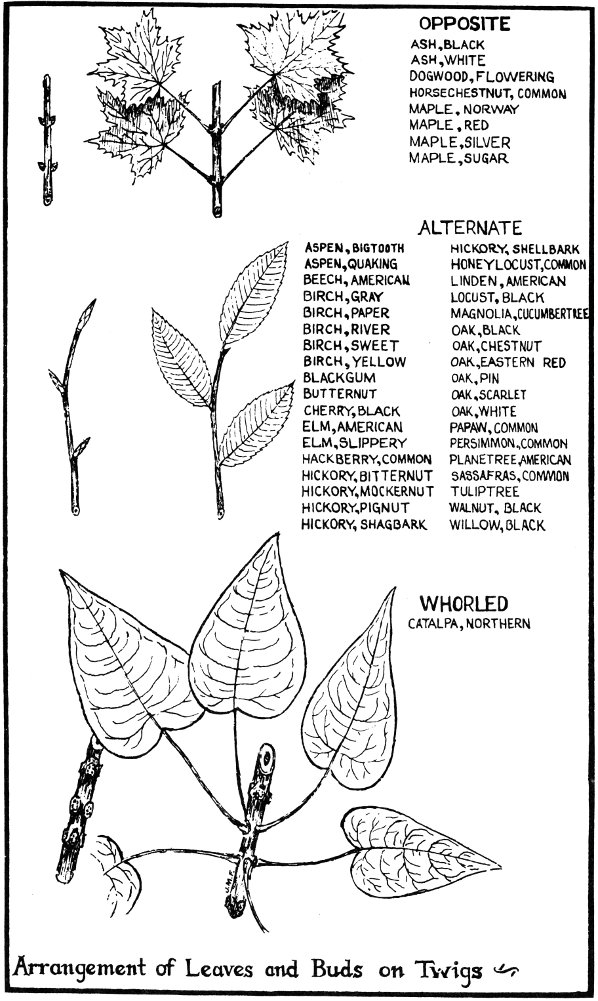
Arrangement of Leaves and Buds on Twigs

EASTERN HEMLOCK
(Tsuga canadensis)
Leaves: Evergreen needles occur singly, spirally arranged on twigs but appear 2-ranked; flattened, about ½″ long; dark green, glossy and often grooved above: light green with 2 white lines below.
Twigs: Slender, rough, yellowish brown to grayish brown. Buds egg-shaped, ¹/₁₆″ long, reddish brown.
Fruit: A cone, ¾″ long, egg-shaped; hangs singly from the tips of the twigs; usually remains attached all winter after ripening in the fall. Under each rounded scale are 2 small winged seeds.
General: Bark on young trees flaky, thick and roughly grooved when old, grayish brown to reddish brown; used in tanning; inner bark cinnamon-red. A large tree, long-lived; shade-enduring. Wood is important for construction lumber.
The Eastern Hemlock is the official State Tree of the Commonwealth of Pennsylvania.

EASTERN WHITE PINE
(Pinus strobus)
Leaves: Evergreen needles in clusters of 5, soft, flexible, 3-sided, 2½″-5″ long, bluish green in appearance due to whitish lines. This is the only 5-needle pine native to Pennsylvania.
Twigs: Slender, flexible, with rusty hairs when young, finally smooth. Buds egg-shaped, usually less than ½″ long; gray-brown.
Fruit: A cone, 5″-8″ long, about 1″ thick, no prickles, stalked, drooping, slightly curved, resinous, remains attached for one to several months after ripening in autumn of second season. Each scale usually bears 2 winged seeds which is characteristic of all native pines.
General: Bark on young trees and branches greenish brown and smooth, later darker, grooved and scaly. Produces one whorl of about 3 to 7 side branches each year, a feature which is useful in estimating age. A large and very important timber tree. Wood probably has more uses than that of any other species.

PITCH PINE
(Pinus rigida)
Leaves: Evergreen needles in clusters of 3, stiff, 2½″-5″ long, yellowish green.
Twigs: Stout, brittle, rough, angled in cross-section, golden-brown. Buds egg-shaped, about ½″ long, resinous, red-brown.
Fruit: A cone, 1½″-3½″ long with short stiff prickles, nearly stalkless, often remains attached for 5 years or more after ripening.
General: Thick, rough, grayish brown bark on older trees. A medium-sized tree. Common on poor, sandy soils and areas where forest fires have killed most other trees. Wood used chiefly for railroad ties, mine props, construction lumber, posts and fuel.

VIRGINIA PINE
(Pinus virginiana)
Leaves: Evergreen needles in clusters of 2, twisted, stout, relatively short (1½″-3″ long), not numerous on twigs.
Twigs: Slender, curved, flexible, brown to purple with bluish white coating. Buds egg-shaped, usually less than ½″ long, brown, resinous.
Fruit: A cone, 2″-3″ long, prickles small but sharp, edge of scales with darker bands; usually without a stalk; remains attached for 3 or 4 years.
General: Smooth, thin, reddish brown, scaly bark. A small tree; able to grow on poor, dry soils. Common on abandoned farm lands where shale soils predominate. Usually grows in dense pure stands. Often called scrub pine. Wood used chiefly for paper pulp, fuel and mine props.

RED PINE
(Pinus resinosa)
Leaves: Evergreen needles in clusters of 2, slender, 4″-6″ long, dark green, borne in dense tufts at the ends of branchlets; snap easily when bent double.
Twigs: Stout, ridged, yellow-brown to red-brown. Buds egg-shaped, about ½″ long, brown at first and later silvery.
Fruit: A cone, about 2″ long, without prickles, nearly stalkless, remains attached until the following year.
General: Comparatively smooth, reddish brown bark. Like white pine, it develops one horizontal whorl of side branches each year. A medium to large-sized tree. Valuable timber tree in the northern part of the State; wood used chiefly for construction lumber.

NORWAY SPRUCE
(Picea abies)
Leaves: Evergreen needles occur singly, spirally arranged on twigs, sharp-pointed, four-sided, usually ¾″ long, dark green.
Twigs: Bright, golden-brown. Buds egg-shaped, darker than twigs.
Fruit: A cylindrical cone, 4″-7″ long, light brown; scales with finely toothed margin, broader than long.
General: Bark relatively thin, reddish brown, scaly, becoming gray-brown but seldom furrowed on old trees. Branchlets on older trees droop. A large tree with a dense, conical crown. A European species that has become a valuable naturalized member of our forests, and extensively planted as an ornamental. Wood used chiefly for paper pulp, boxes, crates and lumber.
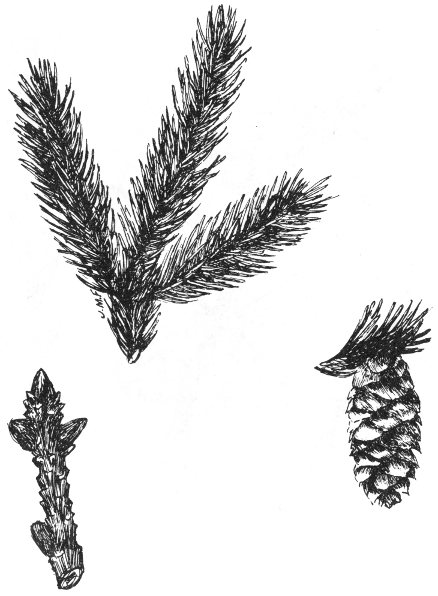
RED SPRUCE
(Picea rubens)
Leaves: Evergreen needles occur singly, spirally arranged on twigs, stiff, four-sided, usually ½″ long, dark green; less sharp than Norway spruce.
Twigs: Orange-brown with very fine hairs. Buds egg-shaped, about ⅓″ long, red-brown.
Fruit: A cone, 2″ or less in length, reddish brown, remains attached for one to several months after ripening in the fall.
General: Bark red-brown, rough, scaly. A medium to large-sized tree. Wood used chiefly for paper pulp, boxes, crates and lumber. Frequents swamps; chiefly in northeastern parts of the State. Black spruce (P. mariana) is a similar but smaller native tree.

EASTERN LARCH
(Larix laricina)
Leaves: Needles not evergreen; occur singly near the ends of the twigs, elsewhere in clusters of 10 or more; about 1″ long, pale green, turning yellow and falling from the tree during the autumn.
Twigs: At first covered with a bluish white coating, becoming dull brown and with numerous short spurs. Buds round, small, ¹/₁₆″ long, dark red.
Fruit: A cone, about ¾″ long, egg-shaped, upright, often remains attached for several years after ripening in the fall.
General: Bark smooth at first, later becoming scaly, dark brown. A medium-sized tree. Only cone-bearing tree native to Pennsylvania that loses its needles annually. Found locally in moist situations. Wood used chiefly for paper pulp, lumber, posts and railroad ties. European larch (L. decidua) and Japanese larch (L. leptolepis) are more commonly planted in the State. Eastern larch is also known as tamarack.
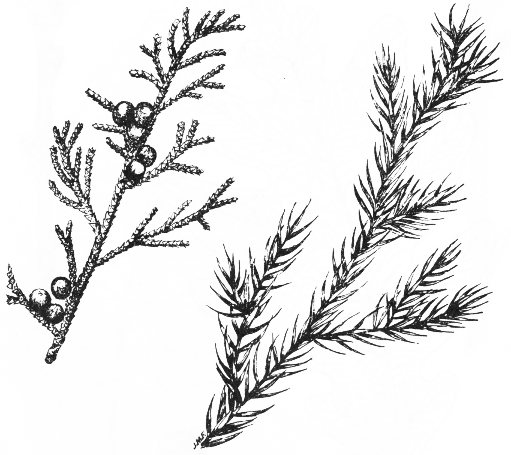
EASTERN REDCEDAR
(Juniperus virginiana)
Leaves: Evergreen, opposite, two types (often on the same tree): the older more common kinds are scale-like and only ¹/₁₆″-³/₃₂″ long, while the young sharp-pointed ones may be up to ¾″ in length; whitish lines on the upper surface.
Twigs: Slender, usually 4-sided, becoming reddish brown. Buds small and not readily noticeable.
Fruit: Bluish berry-like, covered with a whitish powder, about ¼″ in diameter; flesh sweet and resinous: contains 1-2 seeds. Ripens the first year.
General: Bark reddish brown, peeling off in stringy and flaky strips. Usually has a conical crown. Prefers limestone and shale soils. A small to medium-sized tree. Wood used chiefly for fence posts and “cedar chests.” Slow of growth; long-lived.

WHITE OAK
(Quercus alba)
Leaves: Simple, alternate, 6″-9″ long, 5-9 rounded lobes, not bristle-tipped, smooth above and below. Violet-purple in autumn.
Twigs: Red-gray, often with a grayish coating. Buds rounded, reddish brown, smooth, small; end bud about ⅛″ long, often with gray margins on the scales.
Fruit: A sweet acorn, ¾″-1″ long; cup bowl-like, enclosing ¼ of the nut; cup scales warty.
General: Bark gray, usually with shallow fissures and flat scaly ridges but occasionally roughly ridged without scales. A large and valuable tree. Wood uses similar to those of red oak; in addition, used extensively for liquid containers, including whiskey barrels.

CHESTNUT OAK
(Quercus montana)
Leaves: Simple, alternate, 4″-8″ long, thick; large rounded teeth, decreasing in size toward the leaf tips; dark green and smooth above, paler and occasionally downy beneath.
Twigs: Orange-brown to red-brown. Buds light brown, edges of scales lighter colored, sharp-pointed, ¼″-½″ long.
Fruit: An acorn, 1″-1½″ long. Cup thin, enclosing ⅓ of the shiny nut; cup scales knobby. Kernel moderately sweet.
General: Bark at first gray and smooth, later brownish gray to dark gray, thick, tough, deep-fissured; rich in tannin. A medium-sized tree, found mainly on poorer soils of hillsides and rocky ridges. Wood of better-formed trees has same uses as the other oaks. Also known as rock oak.

EASTERN RED OAK
(Quercus borealis maxima)
Leaves: Simple, alternate, 5″-8″ long, 7-11 lobes, bristle-tipped; smooth above and below, but occasionally with small tufts of reddish brown hair beneath.
Twigs: Greenish brown to reddish brown. Buds pointed, light brown, smooth.
Fruit: An acorn, ¾″-1¼″ long; cup usually saucer-shaped, about an inch in diameter, covers only ¼ of the nut; cup scales reddish brown, narrow, tight, sometimes fuzzy on the edges. Kernel bitter as is true of the next 3 species of oaks.
General: Bark brown and gray, with smooth flat-topped ridges separated by shallow fissures when older. A large and rapid-growing tree. Often planted for shade. Wood has many uses; principally utilized for flooring, railroad ties and construction lumber.

SCARLET OAK
(Quercus coccinea)
Leaves: Simple, alternate, 4″-7″ long, 7-9 rather narrow, bristle-tipped lobes; smooth except for small tufts of hair beneath. Very deep spaces between lobes. Generally turn scarlet in autumn.
Twigs: Reddish brown, smooth when mature. Buds blunt-pointed, usually round in cross section, dark reddish brown; upper half wooly.
Fruit: An acorn, ½″-1″ long, kernel white; cup thin, bowl-like, covering about ½ of the nut; cup scales sharp-pointed, smooth, tight.
General: Bark on young trees, smooth, light brown; on older trunks ridged, darker. Inner bark reddish. Drooping dead lower branches persist for many years. A medium to large-sized tree, commonly found on dry soils. Wood inferior to red oak, but often sold under that name.

BLACK OAK
(Quercus velutina)
Leaves: Simple, alternate, 5″-9″ long, 5-7 lobes, bristle-tipped; dark green and usually shiny above; paler, more or less covered with rusty-brown fuzz beneath. Yellowish brown in autumn. Often confused with those of scarlet oak.
Twigs: Reddish brown, usually fuzzy. Buds blunt-pointed, ridged, yellow-gray, wooly.
Fruit: An acorn, about ¾″ long, kernel yellow; cup bowl-like, covering from ⅓ to ½ or more of the nut; cup scales sharp-pointed, form a loose fringe at the rim, covered with whitish wooly hairs.
General: Bark on young stems smooth, dark brown; on older trunks dull black, furrowed, forming irregular blocks. Inner bark orange-yellow. A medium to large-sized tree. Wood has the same uses as that of red oak.

PIN OAK
(Quercus palustris)
Leaves: Similar to those of scarlet oak but generally smaller, fewer-lobed, with more narrow and deeper spaces between lobes. Smooth on both surfaces.
Twigs: Dark red-brown, shiny, slender, often thorn-like. Buds rounded, smooth, smaller than those of scarlet oak.
Fruit: An acorn, about ½″ long, often striped with dark lines; cup thin, saucer-shaped, encloses about ⅓ of nut; cup scales tight, dark-margined.
General: Bark grayish brown, rather smooth for many years; old trunks with shallow fissures and narrow flat ridges. Medium-sized and highly valued street tree. Frequents wet woodland sites. Has the smallest leaves, buds and acorns of all native oaks. Drooping dead lower branches persist for many years. Wood has same uses as red oak but is less desirable because of numerous branch knots.

AMERICAN BEECH
(Fagus grandifolia)
Leaves: Simple, alternate, 3″-4″ long, sharp-toothed, leathery; light green and glossy above, yellow-green with silky hairs below; veins prominent, parallel. Some leaves often cling to the branches all winter.
Twigs: Slender, brownish gray. Buds reddish brown, sharp-pointed, cigar-shaped; end bud ¾″-1″ long.
Fruit: A shiny brown triangled nut, ½″-¾″ long, usually two enclosed in a stalked prickly bur which splits into 4 parts when ripe; edible.
General: Bark smooth, never furrowed, bluish gray throughout life, with dark blotches when older. A large tree. Most numerous in the northern part of the State. Wood used mainly for railroad ties, paper pulp, boxes, furniture and flooring.
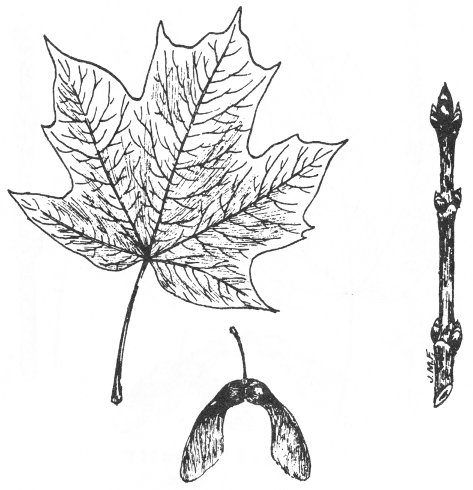
SUGAR MAPLE
(Acer saccharum)
Leaves: Simple, opposite, 5-lobed, about 4″ in diameter; smooth, bright green, paler below; margin with few large teeth.
Twigs: Reddish brown to light brown. Buds brown, sharp-pointed; narrowly cone-shaped.
Fruit: Consists of 2 winged seeds on a stalk; borne in clusters, brown, seed wings ½″ to 1″ long, almost parallel to each other; matures in autumn. Fruit stalks and sometimes the seeds persist into the winter.
General: Bark grayish, on older trunks ridged or with long, thick, curled plates. A large, long-lived, desirable timber and shade tree. Wood used for furniture, flooring; “tapped for sap for making maple syrup.” Often called hard maple.

RED MAPLE
(Acer rubrum)
Leaves: Simple, opposite, generally 3-lobed; about 4″ in diameter; margin with many small teeth.
Twigs: Shiny, green when young, becoming red, with numerous light spots (lenticels). Leaf buds dark red, blunt-pointed; flower buds round, clustered.
Fruit: Paired winged seeds suspended on a slim stem; reddish brown; wing 1″ or less in length; matures in late spring.
General: Bark on young trees gray and smooth, on older trees becoming darker and with long scaly ridges. A medium-sized tree. Common on both swampy and dry sites. A showy tree, usually with reddish flowers and reddish fruit in the spring, and crimson leaves in autumn. Wood has uses similar to those of sugar maple except where strength and hardness are of importance. Often called soft maple.

SILVER MAPLE
(Acer saccharinum)
Leaves: Simple, opposite, 5-lobed, very deep spaces between lobes, teeth coarse; about 5″ in diameter, silvery below.
Twigs: Green in early spring, turning orange-brown, with many light colored dots (lenticels). Distinctive odor when broken. Buds of two distinct types: the small pointed leaf buds toward end of twig, and rounded, clustered flower buds below. Lower branches with up-turned tips.
Fruit: Largest of the native maples; wings may be 2″ long, curving inwards; matures in spring.
General: Bark on young trees smooth and gray; on older trees broken into long, narrow loose strips. A medium-sized tree usually found along streams. Sometimes planted as a shade tree. Wood has uses similar to those of red maple. This species is classed as a soft maple.

NORWAY MAPLE
(Acer platanoides)
Leaves: Simple, opposite, generally 7-lobed, 4½″-5″ in diameter. Milky sap is evident after breaking the leaf stem. Leaves are heavier and thicker than those of sugar maple.
Twigs: Stout, reddish brown. Buds red and green, blunt; end bud much larger than side ones; bud scales with keel-like ridges.
Fruit: Wings wide-spreading, larger than those of sugar maple. Matures in autumn.
General: Bark on young tree light brown, smooth; on older trees it becomes closely fissured but not scaly, dark in color. A tree of medium-size. Imported from Europe and planted extensively as a street tree. The leaves are often attacked by an aphid insect which produces quantities of a sticky substance, spotting vehicles and sidewalks. This species is classed as a soft maple.
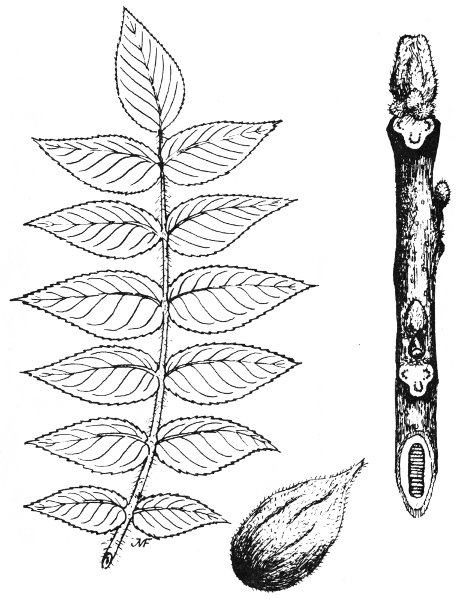
BUTTERNUT
(Juglans cinerea)
Leaves: Compound, alternate; leaflets 11 to 17, each 3″-5″ long, small-toothed; dark yellow-green above, paler, hairy below. End leaflet same size as side leaflets. Main leaf-stem with conspicuous sticky hairs. One of the last trees to unfold its leaves in spring, and the first to shed them in autumn.
Twigs: Stout, greenish-gray to tan, rough, brittle. Pith chocolate-brown, chambered. Buds light brown, hairy, not covered with scales; end bud ½″-¾″ long, side buds smaller. Fringe of short hairs between leaf-scar and bud.
Fruit: An oblong nut, 1½″-2½″ long, covered with a hairy, sticky husk. Nut pointed at one end, shell rough, oily kernel sweet.
General: Bark on young trunks rather smooth, light-gray; later darker, deeply furrowed with wide, smooth, flat-topped ridges. A small to medium-sized tree. Wood used chiefly for furniture, instrument cases, and boxes. Also called white walnut.

EASTERN BLACK WALNUT
(Juglans nigra)
Leaves: Compound, alternate; leaflets 15 to 23, each 3″-4″ long, small-toothed; dark yellow-green above, paler, hairy below. End leaflet absent or very small. Main leaf-stem with very fine hairs.
Twigs: Stout, orange-brown to dark brown, roughened by large leaf scars, easily broken; pith pale brown, chambered. Buds gray, downy; side buds ⅙″ long, end bud larger.
Fruit: A round nut, 1″-2″ in diameter, shell rough, covered with a thick, almost smooth, green spongy husk; oily kernel sweet. Flowers in drooping green catkins, appearing with the unfolding leaves, which is also true of butternut.
General: Bark dark brown to gray-black, with narrow ridges. A large-sized tree, found locally on rich soils mainly in the southern part of the State. Wood valuable for quality furniture, veneer, gun stocks and musical instruments.

SHAGBARK HICKORY
(Carya ovata)
Leaves: Compound, alternate; leaflets usually 5, each 4″ to 7″ long, the lower pair smallest, margins fine-toothed; fragrant when crushed. Larger than those of pignut hickory, with which it is sometimes confused.
Twigs: Stout, often hairy, gray-brown to reddish brown, with numerous light spots (lenticels). Buds large, with 3-4 outer dark brown, loosely fitting, nearly smooth scales; inner scales velvety; end buds ½″-¾″ long.
Fruit: Nearly round, 1″-2½″ in diameter; husk thick, splits into 4 pieces when ripe; nut white, 4-ridged, pointed at one end, usually thin-shelled; kernel sweet.
General: Bark at first smooth and gray, soon breaking into long and loosely-attached plates that gives the trunk a shaggy appearance. A medium-sized tree found on a variety of sites but most common on good soils; grows slowly. Wood used principally for tool handles. The wood of all hickories is valuable to the farmer for fuel and smoking meat.

SHELLBARK HICKORY
(Carya laciniosa)
Leaves: Compound, alternate; leaflets usually 7, each 4″-7″ long, hairy beneath, margins fine-toothed. Dried leaf-stems often cling all winter.
Twigs: Somewhat stouter than shagbark hickory, usually hairy, often angled, orange-brown, with numerous orange spots (lenticels). Buds very large, with 6-8 outer dark brown, loosely fitting keeled scales; end buds ¾″-1″ long. Prominent orange-colored leaf scars.
Fruit: Nearly round to almost egg-shaped, 1¾″-2¾″ long; husk thick, splits into 4 pieces when ripe; nut yellowish white to reddish brown, 4- to 6-ridged, pointed at both ends, usually thick-shelled; kernel sweet. Flowers appear in catkins, as do all the hickories, when leaves are mature.
General: Bark like that of shagbark hickory but often with straighter plates (less shaggy). A medium-sized tree that prefers wet soils. Wood has same uses as shagbark hickory.

MOCKERNUT HICKORY
(Carya tomentosa)
Leaves: Compound, alternate; leaf-stems with fine hairs; leaflets 7 to 9, each 4″-8″ long, margins finely to coarsely toothed; golden glandular dots beneath; very fragrant when crushed.
Twigs: Stout, hairy, reddish brown to brownish gray, with numerous pale spots (lenticels). Buds large, egg-shaped, with 3-5 outer yellowish brown, densely hairy scales; end buds ½″-¾″ long. Leaf scars distinctly 3-lobed.
Fruit: Nearly round to egg-shaped, 1½″-2″ long; husk thick, splits into 4 pieces when ripe; nut reddish brown, slightly ridged, thick-shelled; kernel sweet.
General: Bark gray to dark gray, tight; irregularly shallow-fissured when older. A medium-sized tree found mostly in the southern part of the State. Wood has same uses as shagbark hickory.

PIGNUT HICKORY
(Carya glabra)
Leaves: Compound, alternate; leaflets usually 5, each 3″-6″ long; margins fine-toothed. Entire leaf smooth. Averages smaller than shagbark hickory.
Twigs: Medium-stout, not hairy, reddish brown, with numerous pale spots (lenticels). Buds egg-shaped and pointed, smallest of the native hickories, with more than 6 scales; outer scales often fall off during the winter, end buds ¼″-½″ long.
Fruit: Usually pear-shaped, 1″-2½″ long; husk thin, remains closed or splits partly when ripe; nut brownish white, not ridged, usually thick-shelled; kernel sweet but with bitter after-taste.
General: Bark gray to dark gray, usually tight; shallow fissured when older. A medium-sized tree of drier locations. Wood has same uses as shagbark hickory.
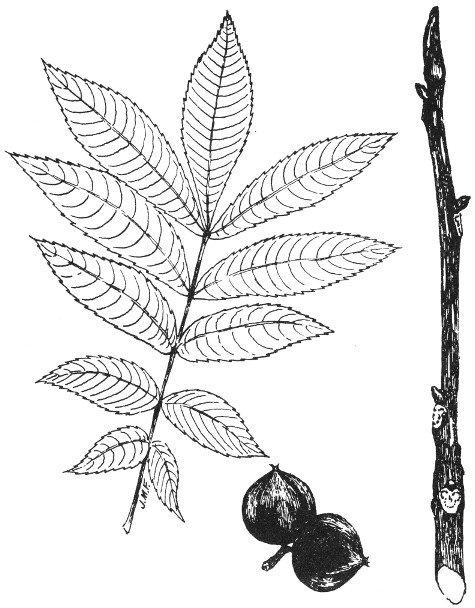
BITTERNUT HICKORY
(Carya cordiformis)
Leaves: Compound, alternate; leaf-stem slender, somewhat downy; leaflets 7-11, each 3″-6″ long, narrow margins finely to coarsely toothed.
Twigs: Medium-stout, smooth, orange-green to gray-brown, with numerous pale spots (lenticels). Buds covered with 4 sulphur-yellow, gland-dotted scales, end buds ⅓″-¾″ long, flattened.
Fruit: Nearly round, ¾″-1½″ in diameter; husk thin, yellowish gland-dotted, splits about to the middle into 4 sections when ripe; nut light reddish brown or gray-brown, not ridged, thin-shelled; kernel with red-brown skin, bitter.
General: Bark gray, tight; remains rather smooth for many years; with narrow ridges when older. A medium-sized tree, usually found near streams; grows more rapidly and its wood is lighter than any of the other native hickories. Wood has same uses as shagbark hickory.

SWEET BIRCH
(Betula lenta)
Leaves: Simple, alternate, about 3½″ long, unevenly saw-toothed; dull green above, yellow-green beneath, with some white hairs at the points where veins join; usually heart-shaped at the base.
Twigs: Green and somewhat downy when young, becoming red-brown, smooth and shiny. Strong wintergreen flavor. Buds reddish brown, sharp-pointed, shiny.
Fruit: A very small winged nut. These nuts, together with small scales, form a cone-like structure about 1½″ long. Sketch shows twig in spring with male and female flowers. All birches have similar fruiting structures.
General: Bark on young trees dark reddish brown, tight, marked with pale horizontal lines (lenticels), resembling bark of young black cherry; becoming black and breaking into large plates. Medium-sized tree. Wood used chiefly for furniture, boxes, and other containers. Distillation of the bark and twigs produces “oil-of-wintergreen.” Also known as black birch.
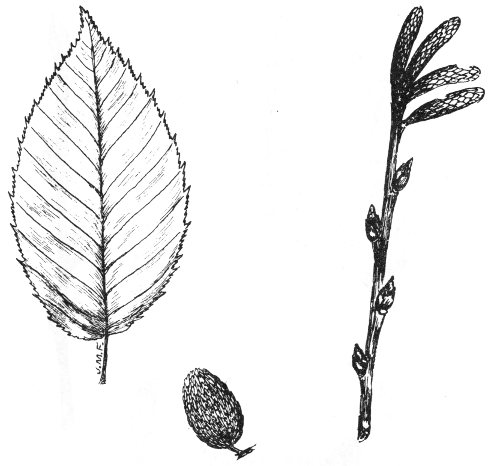
YELLOW BIRCH
(Betula lutea)
Leaves: Simple, alternate; similar to sweet birch but base usually rounded.
Twigs: Like sweet birch but paler, and more downy when young. Wintergreen flavor faint. Buds slightly downy, dull, yellowish brown. Sketch shows winter twig with lateral buds and partially grown female flowers.
Fruit: Similar to sweet birch.
General: Bark on very young trees golden gray, shiny; later yellow, forming ragged ends which curl and can be readily peeled in thin, narrow strips, highly inflammable, and ideal to start a fire under wet conditions. On very old trunks bark becomes darker, coarse and platy. A medium to large tree. Found mostly in the northern part of the State. Wood principally used for furniture, interior finish, boxes and other containers.

RIVER BIRCH
(Betula nigra)
Leaves: Simple, alternate, 1½″-3″ long, dark green above, yellow-green below, wedge-shaped at the base, margins usually with large teeth.
Twigs: Slender, at first greenish and hairy, later turning reddish brown, smooth; with pale horizontal lines (lenticels). Buds sharp-pointed and shiny, smooth or slightly fuzzy.
Fruit: Similar to sweet birch.
General: Bark reddish brown or cinnamon, peeling off in curled, shaggy strips; on older trunks becoming dark colored and rough. Medium-sized tree; found almost entirely along the lower reaches of our larger streams. Wood lighter, softer, and less valuable than sweet birch and yellow birch.

PAPER BIRCH
(Betula papyrifera)
Leaves: Simple, alternate, 2″-3″ long, oval, sharply toothed, dark green above, lighter below.
Twigs: At early age greenish and fuzzy, later turning dark gray; irregularly marked with raised orange colored dots (lenticels). Buds dark brown, sticky. Immature male catkins at the ends of the twigs in autumn and winter, as is true of all the birches.
Fruit: Similar to sweet birch. Mature in July.
General: Bark creamy, to chalky white, peeling easily. Once the bark is removed, it is not renewed. A small to medium-sized tree. Often found with several stems growing together, occurring naturally only in the northern part of the State. Also called canoe birch and white birch. Wood has uses similar to those of yellow birch, but principally used for spools, clothes-pins, toothpicks and paper pulp.

GRAY BIRCH
(Betula populifolia)
Leaves: Simple, alternate, triangular in shape, with long tapering point, 2½″-3″ long, smooth above and below, tremulous. Leaf-stems very slender. Turn yellow in autumn, as is true of all birches.
Twigs: Slender, greenish brown, rough due to small warty glands. Buds sharp-pointed, gummy.
Fruit: Similar to sweet birch but shorter (¾″ long).
General: Bark dull white, not peeling into thin paper-like layers as is the case with paper birch; dark colored on the branches; orange inner bark. Usually with triangular-shaped black patches on the trunk. A small short-lived tree, usually growing in clumps. Occurs chiefly in the northeastern counties. Wood of little commercial value; chiefly used for fuel.
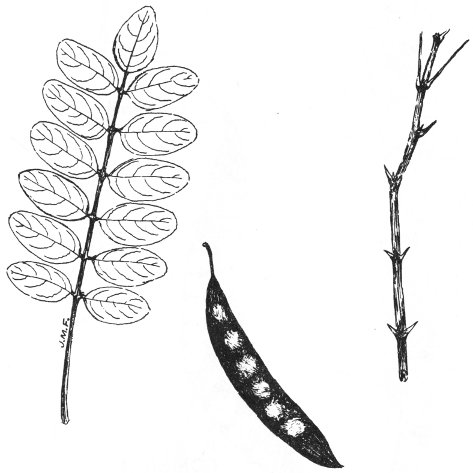
BLACK LOCUST
(Robinia pseudoacacia)
Leaves: Compound, alternate; leaflets 1″-2″ long, margins smooth.
Twigs: Angled, somewhat zigzag, brittle, with short stout prickles; no end bud, side buds small and hidden in winter.
Fruit: A thin, flat pod, 2″-4″ long; usually with 4-8 seeds; splits into halves when ripe. Flowers white, showy, very fragrant in drooping clusters, appearing in May and June.
General: Bark rough, furrowed, thick. A medium-sized tree. Often seen along farm fences and roads. Wood is durable in contact with the soil and in demand for posts, poles, railroad ties, and mine timbers. Unfortunately, several insects and wood rots often cause heavy damage, especially to trees on poor soils.

COMMON HONEYLOCUST
(Gleditsia triacanthos)
Leaves: Compound and doubly-compound, alternate; leaf-stem grooved above, hairy; leaflets 1″ long, usually fine-toothed on margins.
Twigs: Medium stout, shiny, greenish brown to reddish brown, zigzag, smooth, often with long branched thorns; no end bud, very small side buds.
Fruit: A leathery pod, 10″-18″ long, flat, usually twisted, with numerous seeds; often of high sugar content; eaten by some animals. Does not split into 2 halves, as does the pod of black locust.
General: Bark on young trees greenish brown with many long, raised, horizontal lines (lenticels); later brown to nearly black, fissured and with thick plates. A medium-sized tree; usually found as a native near streams; also planted as a shade tree. Branched thorns on the trunk and limbs make it easy to identify in winter. There is a thornless variety. Wood is mainly used for fence posts, general construction, and furniture.
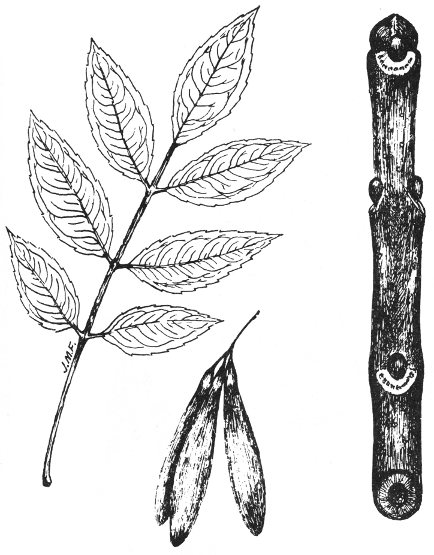
WHITE ASH
(Fraxinus americana)
Leaves: Compound, opposite; leaflets 5-9, each 3″-5″ long, stalked, somewhat silvery beneath; margins entire or with few rounded teeth toward the tip.
Twigs: Stout, usually smooth, gray-brown, with few large pale spots (lenticels). Buds blunt, dark brown. Leaf scars half-circular but notched at top.
Fruit: A winged seed, 1″-2″ long, ¼″ wide, shaped like a canoe paddle, in hanging clusters which often remain attached for several months after ripening in autumn.
General: Bark gray-brown, with diamond-shaped fissures when older. A large tree; trunk usually long and straight; commonly occurring on rich soils. Wood important for such special uses as handles, vehicle parts and athletic equipment (practically all baseball bats); valuable for curved parts in furniture.

BLACK ASH
(Fraxinus nigra)
Leaves: Compound, opposite; leaflets 7-11, each 3″-5″ long, not stalked except end one, dark green above, lighter green beneath with some rusty hairs; margins saw-toothed.
Twigs: Stout, at first somewhat hairy, becoming smooth, gray or red-brown, with many large pale spots (lenticels). Buds dark brown to black, end bud pointed. Leaf scars nearly circular, with raised margins; not notched at the top.
Fruit: Resembles that of white ash but is usually smaller (1″-1¾″ long and ⅜″ wide).
General: Bark grayish, when older becoming corky-ridged or scaly; knobs frequent on the trunk. A medium-sized tree that prefers cool, swampy sites. Wood is generally lighter in weight and weaker than white ash but used for the same purposes.

TULIPTREE
(Liriodendron tulipfera)
Leaves: Simple, alternate, 4″-6″ in diameter, generally 4-lobed, bright green, turning yellow in autumn.
Twigs: In spring and summer, green, sometimes with purplish tinge; during winter reddish brown, smooth, shiny. Buds large, smooth, flattened, “duck-billed.”
Fruit: At first green, turning light brown when ripe in autumn; cone-like, 2½″-3″ long, made up of winged seeds. Greenish yellow tulip-like flowers in May or June.
General: Bark at first dark green and smooth; whitish vertical streaks soon appearing; later dark gray and furrowed. A large tree, the tallest of the eastern hardwoods. It grows rapidly and is an important timber and shade tree. The wood is valuable for veneer and many other uses. Also known as tulip poplar.

CUCUMBERTREE MAGNOLIA
(Magnolia acuminata)
Leaves: Simple, alternate, 4″-12″ long, smooth above, downy beneath; margins smooth or sometimes wavy.
Twigs: Reddish brown, shiny, with peppery smell and taste. Buds covered with greenish white silky hairs; end buds ½″-¾″ long. Leaf scars horseshoe shaped.
Fruit: When young, like a small green cucumber. When mature in autumn, 3″-4″ long, a cluster of small red pods, each containing two scarlet seeds; often remains attached all winter. Flowers large (3″ long), greenish yellow, single, upright; appear from April to June.
General: Bark gray-brown to brown, developing long narrow furrows and loose scaly ridges. A medium-sized tree, found mainly in the western half of the State. Wood used mainly for interior finish, furniture and containers.

AMERICAN ELM
(Ulmus americana)
Leaves: Simple, alternate, 4″-6″ long, unequal at the base, rather rough on the upper surface; usually soft-hairy below; veins prominent; margin coarsely toothed. Leaf-stem short.
Twigs: Slender, zigzag, brown, smooth or slightly hairy. Leaf buds ⅛″-¼″ long, flattened. Flower buds larger, below leaf buds. Bud scales red-brown, smooth or downy; margins dark.
Fruit: A seed surrounded by an oval, thin papery wing, ½″ long, deeply notched at the tip; ripening in spring and borne in clusters; wing with scattered hairs along margin. Flowers and fruit appear before the leaves, as is true of slippery elm.
General: Bark dark gray to gray-brown, with long corky ridges; on older trees separated by diamond-shaped fissures. A large and highly prized shade tree. The drooping crown often gives it a vase-shaped appearance. Found locally throughout Pennsylvania, mainly on moist areas. The hard, tough wood has many uses, including the manufacture of boxes, barrels and furniture.

SLIPPERY ELM
(Ulmus fulva)
Leaves: Simple, alternate, 5″-7″ long; usually larger than those of American elm, rough on both sides or soft-hairy below; margin coarsely toothed. Leaf-stem short.
Twigs: Stouter than on American elm, grayish and rather rough. Buds slightly larger than those of American elm, and more round—seldom flattened. Bud scales brown to almost black, rusty-haired.
Fruit: Like that of American elm but somewhat larger (¾″ long); wing margin not hairy and slightly notched at the tip.
General: Bark similar to American elm but of lighter color, softer, and fissures not diamond-shaped in outline. Inner bark sticky and fragrant. A medium-sized tree usually found near streams. Crown does not droop like that of American elm. The wood is commonly marketed with the preceding species.
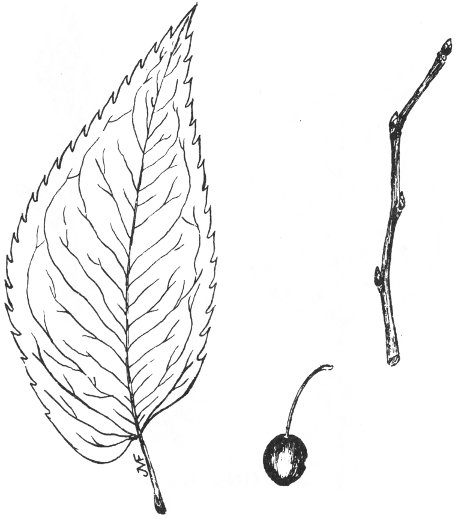
COMMON HACKBERRY
(Celtis occidentalis)
Leaves: Simple, alternate, 2″-4″ long, slender pointed; margin sharp toothed; base unequal; often rough above, slightly hairy and veins prominent on undersides; 3-veined at base. Leaf-stem somewhat downy and grooved; fairly long (compared to elm).
Twigs: Slender, reddish brown, with chambered white pith. Buds small, sharp-pointed, closely pressed to the twig.
Fruit: Resembles a cherry, dark purple in color, ¼″-½″ diameter, sweet but with very little flesh covering the pitted stone; borne singly on a long slender stem; ripens in autumn.
General: Bark gray-brown with characteristic warty projections or irregular ridges. A small tree. “Witches-brooms” are common. Most common on limestone soils in moist locations. Sometimes mistaken for elm. Wood used principally for furniture, boxes and other containers.

QUAKING ASPEN
(Populus tremuloides)
Leaves: Simple, alternate, 1½″-3″ in diameter, light green, smooth above and below, nearly circular; margins with fine teeth; leaf-stems thin and flattened, causing the leaves to tremble in the slightest breeze. Yellowish-green when unfolding in spring.
Twigs: Slender, reddish brown, smooth, shiny. Pith star-shaped, white. Buds sharp-pointed, smooth, shiny, often curved inward.
Fruit: A small (¼″ long) capsule containing 10-12 seeds; capsules spirally arranged on a 4″ long drooping stalk, maturing in early summer. Each tiny cottony seed surrounded by long silky threads.
General: Bark thin, pale yellow-green to silvery gray when young, eventually becoming dark brown or gray and rough. A small to medium-sized tree, of rapid growth but short-lived. Often one of the first forest trees to become established on recently burned areas; the most widely distributed tree of North America. Most common in northern Pennsylvania. Wood used chiefly for paper pulp.
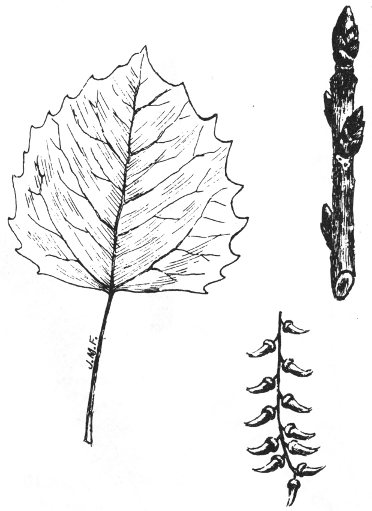
BIGTOOTH ASPEN
(Populus grandidentata)
Leaves: Simple, alternate, 3″-4″ long, dark green above, paler below, margins with coarse teeth; leaf-stems flattened; silvery when unfolding in spring.
Twigs: Rather stout, brownish gray, sometimes with a coating of pale, wooly down. Buds blunt-pointed, dull, seldom curved, often wooly.
Fruit: Similar to quaking aspen. Flowers, in the form of hanging catkins, appear before the leaves in the spring, as is the case with quaking aspen.
General: Bark similar to that of quaking aspen, but usually darker. A small to medium-sized tree; short-lived. Most common in southern Pennsylvania. Wood used chiefly for paper pulp.

BLACK WILLOW
(Salix nigra)
Leaves: Simple, alternate, long and narrow, short-stemmed, sharp pointed, fine teeth on the margin, average length 3″; dark green above, much lighter below. The stipules (“small leaves” at the base of leaf-stems of the main leaves) remain through most of the summer.
Twigs: Slender, brittle at the base, bright reddish brown to orange-green. Buds covered by a single scale, small, cone-shaped, sharp-pointed.
Fruit: Small brown capsule, ¼″ long, borne in long hanging clusters; ripens in May or June. Each tiny seed surrounded by tufts of long silky hair.
General: Bark thick, dark brown, separating into broad, flat plates or ridges as the tree grows older. A small to medium-sized tree. Only native willow which grows to a fair size. Found mainly in moist situations. Often several trunks arise from the same root system. Weeping willow (S. babylonica) and brittle willow (S. fragilis) are introduced trees often planted for ornamental purposes.

BLACK CHERRY
(Prunus serotina)
Leaves: Simple, alternate, narrow, with tapering tip, shiny above, paler below and usually with reddish brown hairs near the base; 2″-5″ long, margins with short incurved teeth.
Twigs: Smooth, reddish brown, often covered with a thin gray coating which peels or rubs off easily; bitter when chewed; with minute, rounded gray lenticels. Buds smooth, shiny, sharp-pointed, same color as twigs but often tinged with green.
Fruit: Round, black with a purplish tint, ⅓″-½″ in diameter, containing a single round, stony seed. Arranged in hanging clusters. Flowers white, in 4″-long upright clusters in June.
General: Bark on young trunks smooth, dark red-brown, marked with numerous raised horizontal lines (lenticels), somewhat resembling that of sweet birch; later breaking into thick irregular plates with upturned edges. A large tree in the northern part of the State; medium-sized in the southern counties. Wood used chiefly for quality furniture and interior finish.

BLACK GUM
(Nyssa sylvatica)
Leaves: Simple, alternate, 2″-4″ long, entire or wavy margin; dark green and shiny above, often downy on the underside; turning a vivid red in early autumn.
Twigs: Smooth, grayish to reddish brown; the white pith separated by dark lines. Buds rounded in cross section, pointed, reddish brown, ¼″ long.
Fruit: Cherry-like, ⅓″-⅔″ long, dark blue, 1-seeded, with thin flesh; borne singly or in 2’s or 3’s in a cluster; ripens in autumn.
General: Bark on young trees smooth or scaly, light gray; on older trunks dark gray, broken into blocks and resembling alligator hide. A medium-sized tree, often flat-topped, with horizontal branches and short spur-like twigs. Grows mainly on swampy lands, but found elsewhere. Wood very difficult to split; used chiefly for boxes, fuel and railroad ties.
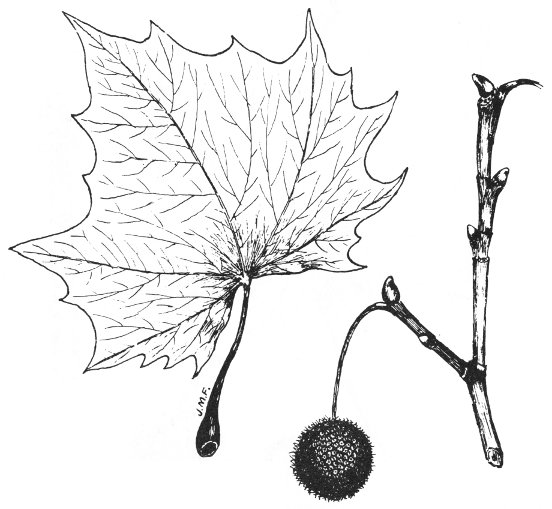
AMERICAN PLANETREE
(Platanus occidentalis)
Leaves: Simple, alternate, 3-5 lobed, 4″-7″ across, generally wider than long; light green above, paler and wooly beneath. Base of leaf-stem hollow, enclosing next year’s bud.
Twigs: At first green and hairy, later brownish, smooth; zigzag. Buds cone-like with a single smooth, reddish brown scale.
Fruit: A round “button-ball,” single or occasionally in 2’s on a tough slender stalk. These fruit clusters are light brown, 1″-1¼″ in diameter, consist of many seeds, each surrounded at the base by silky hairs; usually hang throughout the winter.
General: Bark of two layers, the outer peeling in brown flakes, the inner whitish, yellowish or greenish; on base of old trunks dark brown and fissured. A tree of large size; mature trees often very massive. Prefers stream banks. Wood used for furniture, crates, butcher blocks, and flooring. Also known as American sycamore. The London planetree (P. acerifolia), with 2, sometimes 3, “button-balls” on a stalk, is more commonly planted as a shade tree.

COMMON HORSECHESTNUT
(Aesculus hippocastanum)
Leaves: Palmately compound, opposite; usually with 7 leaflets, each 4″-9″ long, wedge-shaped, long-pointed, smooth when full-grown; turning a rusty yellow in autumn.
Twigs: Stout, usually not hairy. Buds blackish brown, sticky, large; end bud ½″-1″ long.
Fruit: Roundish capsule, 1½″-2½″ in diameter, green husk with prickles; breaks into three parts when ripe releasing 1 or 2 large, shiny brown, non-edible seeds. Flower ¾″ long; showy-white and spotted with yellow and red. Flower clusters erect, 8″-12″ long.
General: Bark grayish, broken into thin plates. A medium to large-sized tree. Introduced from Europe and is a common shade tree in the State. Leaves are often browned by diseases. Also known as European buckeye. Two rather similar trees are native to southern Pennsylvania—Ohio buckeye (A. glabra) and yellow buckeye (A. octandra).
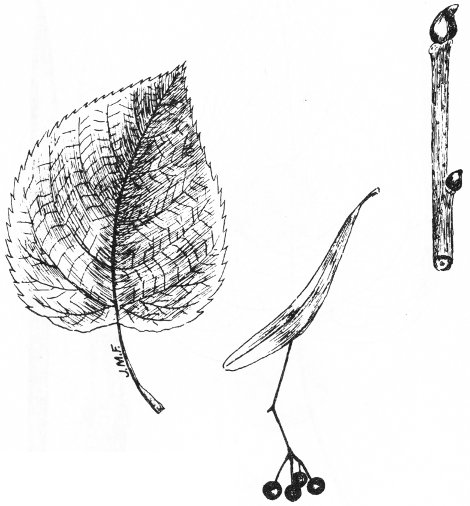
AMERICAN LINDEN
(Tilia americana)
Leaves: Simple, alternate, somewhat heart-shaped, 4″-7″ long, shiny dark green on top, smooth beneath except for tufts of rusty hair; sharply toothed on margin.
Twigs: Green or reddish when young, turning brownish red; usually zigzag. Buds deep red to greenish, usually lopsided, with 2-3 visible scales.
Fruit: Nutlike, thick-shelled, downy, about the size of a pea; borne in groups from a long stem attached to narrow leaflike blade or bract. The clustered fruit and bracts may remain on the tree until late winter. Flowers yellowish white, fragrant.
General: Bark on young trunks smooth, tough, dark gray; on older trees broken into narrow, scaly ridges. A large tree; usually found in mixture with other hardwoods on moist, rich valley soils. Wood is used for a variety of products including boxes, venetian blinds, sashes, doors, picture frames, and furniture. Also known as basswood.

NORTHERN CATALPA
(Catalpa speciosa)
Leaves: In whorls of 3 or more, occasionally opposite, heart-shaped, 8″-12″ long and 6″-8″ wide; margin entire or wavy; smooth above, hairy beneath.
Twigs: Stout, yellow-brown; no buds at the ends. Side buds small, appear to be hidden in bark. Large, nearly round, depressed leaf scars are characteristic.
Fruit: Bean-like, 8″-18″ long, narrow; pod separates into two halves when ripe, hang on tips of branches all winter; many seeds, each with long white hairs on both ends. Flowers in July, arranged in terminal clusters about 8″ long; each showy flower white with yellow and purple spots, 2″-3″ in diameter.
General: Bark light brown, scaly; slightly furrowed on older trees. A medium to large-sized tree. Native to the Mississippi Valley. Usually planted for shade purposes in this State but its wood is durable and useful for posts. The less hardy Southern catalpa (C. bignonioides) with slender pods has also been planted in Pennsylvania.
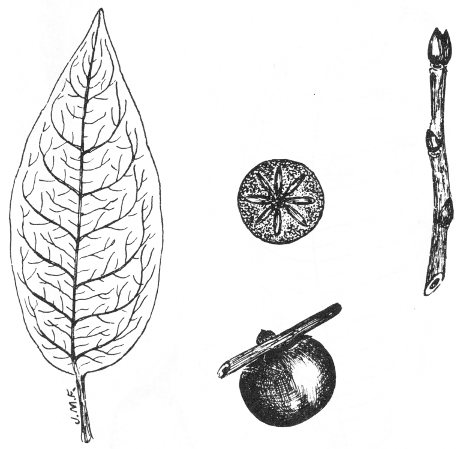
COMMON PERSIMMON
(Diospyros virginiana)
Leaves: Simple, alternate, 4″-6″ long, dark green and glossy above, paler and often wooly below; margins smooth or wavy.
Twigs: Grayish brown, smooth, sometimes velvety. No end bud; each side bud covered by 2 glossy dark brown scales.
Fruit: Fleshy berry, large (¾″-2″ in diameter), plum-like, orange to red, parts of the flower remain attached to the base (see sketch); seeds 1-8, flat, rather large. Edible but often astringent when fully ripe in autumn.
General: Bark dark gray to dark brown, separated into small blocks by cinnamon-red bottomed furrows. A small to medium-sized tree native to the southern part of the State. Wood hard, tough, used chiefly for special products such as shuttles for weaving, spools, and golf-club heads.

COMMON PAWPAW
(Asimina triloba)
Leaves: Simple, alternate, 5″-12″ long, drooping; somewhat like the leaf of cucumbertree magnolia; dark green above, light green below; margins smooth or wavy.
Twigs: Olive-brown, enlarged at points where leaves are attached, somewhat hairy toward tips. Buds brown, hairy, not covered with scales.
Fruit: Looks like a short stubby banana, greenish yellow at first, brown when ripe in autumn, 3″-5″ long, edible; contains numerous brown, shiny seeds imbedded in the fragrant outer pulp. Flowers greenish-brown to purple, 1″ across, solitary, appear before the leaves.
General: Bark dark brown, thin, slightly fissured on older trees, often marked with white blotches. A small tree. Generally found in the understory of the forest in the southern half of the State on rich moist soil. The fruit is of more value than its wood which is sometimes used for fuel.

COMMON SASSAFRAS
(Sassafras albidum)
Leaves: Simple, alternate, 4″-6″ long, characteristically aromatic when crushed. Usually three types can be found on a tree: entire, 2-lobed and 3-lobed (rarely 5-lobed). Smooth, dark green above, much lighter beneath.
Twigs: Bright green, sometimes reddish, smooth and shiny; large white pith. End bud much larger than side ones, with many loose scales.
Fruit: Cherry-like, dark blue, shiny, about ½″ in diameter, on a red stem enlarged at the point of attachment. Borne in clusters. Yellow flowers appear before the leaves unfold.
General: Bark on young trees soon becomes furrowed, the greenish bark changing to brown; inner bark salmon colored; older trees show deep fissures extending long distances up the trunk. A small to medium-sized tree, with crooked branches; often spreading by root suckers. Its roots, leaves, twigs and fruit have a spicy odor; the oil contained in these parts is used for a “tea,” in medicines, perfumes, etc. Wood used chiefly for fuel and fence posts.

FLOWERING DOGWOOD
(Cornus florida)
Leaves: Simple, opposite, 3″-5″ long; clustered toward tips of twigs; margins smooth or wavy; veins prominent and curved like a bow. Foliage bright red in autumn.
Twigs: Red tinged with green, often with a bluish white powdery coating; marked with rings; tips curve upward. End leaf bud covered by 2 reddish scales; side leaf buds very small; flower buds conspicuous, silvery, button-shaped, at ends of twigs.
Fruit: An egg-shaped drupe, ½″-⅗″ long; coat red; flesh yellowish; stone grooved, 2-celled; usually in clusters of 2-5; persist after the leaves fall. Flowers greenish white or yellowish, small, in flat-topped clusters; four showy white bracts underneath; open before the leaves.
General: Bark red-brown to reddish gray, broken by fissures into small blocks, like alligator hide. A small native tree with low spreading crown, especially valued for ornamental planting. Wood used primarily for textile weaving shuttles. There is a variety with red or pink bracts.
A B C D E F G H I J K L M N O P Q R S T U V W X Y Z
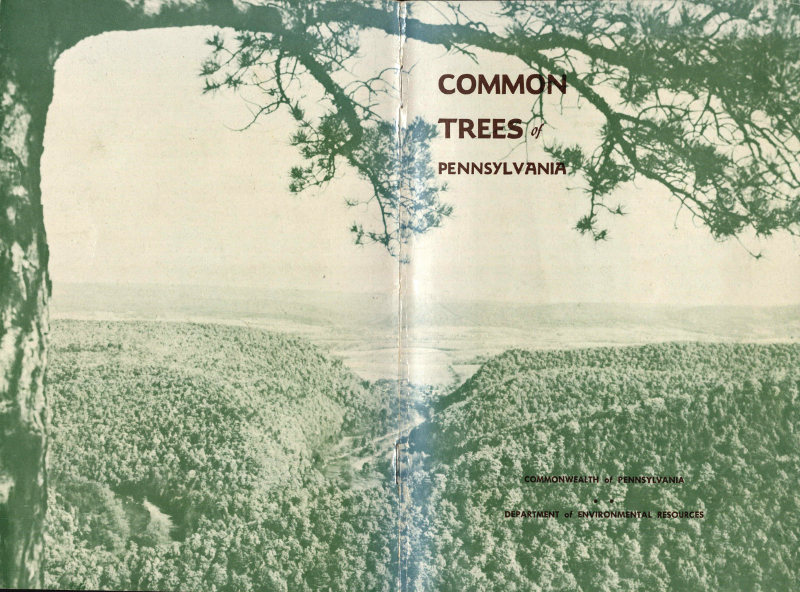
End of the Project Gutenberg EBook of Common Trees of Pennsylvania, by
J. E. Ibberson and A. B. Mickalitis and J. E. Aughenbaugh and C. L. Morris
*** END OF THIS PROJECT GUTENBERG EBOOK COMMON TREES OF PENNSYLVANIA ***
***** This file should be named 53535-h.htm or 53535-h.zip *****
This and all associated files of various formats will be found in:
http://www.gutenberg.org/5/3/5/3/53535/
Produced by Stephen Hutcheson, MFR and the Online
Distributed Proofreading Team at http://www.pgdp.net
Updated editions will replace the previous one--the old editions will
be renamed.
Creating the works from print editions not protected by U.S. copyright
law means that no one owns a United States copyright in these works,
so the Foundation (and you!) can copy and distribute it in the United
States without permission and without paying copyright
royalties. Special rules, set forth in the General Terms of Use part
of this license, apply to copying and distributing Project
Gutenberg-tm electronic works to protect the PROJECT GUTENBERG-tm
concept and trademark. Project Gutenberg is a registered trademark,
and may not be used if you charge for the eBooks, unless you receive
specific permission. If you do not charge anything for copies of this
eBook, complying with the rules is very easy. You may use this eBook
for nearly any purpose such as creation of derivative works, reports,
performances and research. They may be modified and printed and given
away--you may do practically ANYTHING in the United States with eBooks
not protected by U.S. copyright law. Redistribution is subject to the
trademark license, especially commercial redistribution.
START: FULL LICENSE
THE FULL PROJECT GUTENBERG LICENSE
PLEASE READ THIS BEFORE YOU DISTRIBUTE OR USE THIS WORK
To protect the Project Gutenberg-tm mission of promoting the free
distribution of electronic works, by using or distributing this work
(or any other work associated in any way with the phrase "Project
Gutenberg"), you agree to comply with all the terms of the Full
Project Gutenberg-tm License available with this file or online at
www.gutenberg.org/license.
Section 1. General Terms of Use and Redistributing Project
Gutenberg-tm electronic works
1.A. By reading or using any part of this Project Gutenberg-tm
electronic work, you indicate that you have read, understand, agree to
and accept all the terms of this license and intellectual property
(trademark/copyright) agreement. If you do not agree to abide by all
the terms of this agreement, you must cease using and return or
destroy all copies of Project Gutenberg-tm electronic works in your
possession. If you paid a fee for obtaining a copy of or access to a
Project Gutenberg-tm electronic work and you do not agree to be bound
by the terms of this agreement, you may obtain a refund from the
person or entity to whom you paid the fee as set forth in paragraph
1.E.8.
1.B. "Project Gutenberg" is a registered trademark. It may only be
used on or associated in any way with an electronic work by people who
agree to be bound by the terms of this agreement. There are a few
things that you can do with most Project Gutenberg-tm electronic works
even without complying with the full terms of this agreement. See
paragraph 1.C below. There are a lot of things you can do with Project
Gutenberg-tm electronic works if you follow the terms of this
agreement and help preserve free future access to Project Gutenberg-tm
electronic works. See paragraph 1.E below.
1.C. The Project Gutenberg Literary Archive Foundation ("the
Foundation" or PGLAF), owns a compilation copyright in the collection
of Project Gutenberg-tm electronic works. Nearly all the individual
works in the collection are in the public domain in the United
States. If an individual work is unprotected by copyright law in the
United States and you are located in the United States, we do not
claim a right to prevent you from copying, distributing, performing,
displaying or creating derivative works based on the work as long as
all references to Project Gutenberg are removed. Of course, we hope
that you will support the Project Gutenberg-tm mission of promoting
free access to electronic works by freely sharing Project Gutenberg-tm
works in compliance with the terms of this agreement for keeping the
Project Gutenberg-tm name associated with the work. You can easily
comply with the terms of this agreement by keeping this work in the
same format with its attached full Project Gutenberg-tm License when
you share it without charge with others.
1.D. The copyright laws of the place where you are located also govern
what you can do with this work. Copyright laws in most countries are
in a constant state of change. If you are outside the United States,
check the laws of your country in addition to the terms of this
agreement before downloading, copying, displaying, performing,
distributing or creating derivative works based on this work or any
other Project Gutenberg-tm work. The Foundation makes no
representations concerning the copyright status of any work in any
country outside the United States.
1.E. Unless you have removed all references to Project Gutenberg:
1.E.1. The following sentence, with active links to, or other
immediate access to, the full Project Gutenberg-tm License must appear
prominently whenever any copy of a Project Gutenberg-tm work (any work
on which the phrase "Project Gutenberg" appears, or with which the
phrase "Project Gutenberg" is associated) is accessed, displayed,
performed, viewed, copied or distributed:
This eBook is for the use of anyone anywhere in the United States and
most other parts of the world at no cost and with almost no
restrictions whatsoever. You may copy it, give it away or re-use it
under the terms of the Project Gutenberg License included with this
eBook or online at www.gutenberg.org. If you are not located in the
United States, you'll have to check the laws of the country where you
are located before using this ebook.
1.E.2. If an individual Project Gutenberg-tm electronic work is
derived from texts not protected by U.S. copyright law (does not
contain a notice indicating that it is posted with permission of the
copyright holder), the work can be copied and distributed to anyone in
the United States without paying any fees or charges. If you are
redistributing or providing access to a work with the phrase "Project
Gutenberg" associated with or appearing on the work, you must comply
either with the requirements of paragraphs 1.E.1 through 1.E.7 or
obtain permission for the use of the work and the Project Gutenberg-tm
trademark as set forth in paragraphs 1.E.8 or 1.E.9.
1.E.3. If an individual Project Gutenberg-tm electronic work is posted
with the permission of the copyright holder, your use and distribution
must comply with both paragraphs 1.E.1 through 1.E.7 and any
additional terms imposed by the copyright holder. Additional terms
will be linked to the Project Gutenberg-tm License for all works
posted with the permission of the copyright holder found at the
beginning of this work.
1.E.4. Do not unlink or detach or remove the full Project Gutenberg-tm
License terms from this work, or any files containing a part of this
work or any other work associated with Project Gutenberg-tm.
1.E.5. Do not copy, display, perform, distribute or redistribute this
electronic work, or any part of this electronic work, without
prominently displaying the sentence set forth in paragraph 1.E.1 with
active links or immediate access to the full terms of the Project
Gutenberg-tm License.
1.E.6. You may convert to and distribute this work in any binary,
compressed, marked up, nonproprietary or proprietary form, including
any word processing or hypertext form. However, if you provide access
to or distribute copies of a Project Gutenberg-tm work in a format
other than "Plain Vanilla ASCII" or other format used in the official
version posted on the official Project Gutenberg-tm web site
(www.gutenberg.org), you must, at no additional cost, fee or expense
to the user, provide a copy, a means of exporting a copy, or a means
of obtaining a copy upon request, of the work in its original "Plain
Vanilla ASCII" or other form. Any alternate format must include the
full Project Gutenberg-tm License as specified in paragraph 1.E.1.
1.E.7. Do not charge a fee for access to, viewing, displaying,
performing, copying or distributing any Project Gutenberg-tm works
unless you comply with paragraph 1.E.8 or 1.E.9.
1.E.8. You may charge a reasonable fee for copies of or providing
access to or distributing Project Gutenberg-tm electronic works
provided that
* You pay a royalty fee of 20% of the gross profits you derive from
the use of Project Gutenberg-tm works calculated using the method
you already use to calculate your applicable taxes. The fee is owed
to the owner of the Project Gutenberg-tm trademark, but he has
agreed to donate royalties under this paragraph to the Project
Gutenberg Literary Archive Foundation. Royalty payments must be paid
within 60 days following each date on which you prepare (or are
legally required to prepare) your periodic tax returns. Royalty
payments should be clearly marked as such and sent to the Project
Gutenberg Literary Archive Foundation at the address specified in
Section 4, "Information about donations to the Project Gutenberg
Literary Archive Foundation."
* You provide a full refund of any money paid by a user who notifies
you in writing (or by e-mail) within 30 days of receipt that s/he
does not agree to the terms of the full Project Gutenberg-tm
License. You must require such a user to return or destroy all
copies of the works possessed in a physical medium and discontinue
all use of and all access to other copies of Project Gutenberg-tm
works.
* You provide, in accordance with paragraph 1.F.3, a full refund of
any money paid for a work or a replacement copy, if a defect in the
electronic work is discovered and reported to you within 90 days of
receipt of the work.
* You comply with all other terms of this agreement for free
distribution of Project Gutenberg-tm works.
1.E.9. If you wish to charge a fee or distribute a Project
Gutenberg-tm electronic work or group of works on different terms than
are set forth in this agreement, you must obtain permission in writing
from both the Project Gutenberg Literary Archive Foundation and The
Project Gutenberg Trademark LLC, the owner of the Project Gutenberg-tm
trademark. Contact the Foundation as set forth in Section 3 below.
1.F.
1.F.1. Project Gutenberg volunteers and employees expend considerable
effort to identify, do copyright research on, transcribe and proofread
works not protected by U.S. copyright law in creating the Project
Gutenberg-tm collection. Despite these efforts, Project Gutenberg-tm
electronic works, and the medium on which they may be stored, may
contain "Defects," such as, but not limited to, incomplete, inaccurate
or corrupt data, transcription errors, a copyright or other
intellectual property infringement, a defective or damaged disk or
other medium, a computer virus, or computer codes that damage or
cannot be read by your equipment.
1.F.2. LIMITED WARRANTY, DISCLAIMER OF DAMAGES - Except for the "Right
of Replacement or Refund" described in paragraph 1.F.3, the Project
Gutenberg Literary Archive Foundation, the owner of the Project
Gutenberg-tm trademark, and any other party distributing a Project
Gutenberg-tm electronic work under this agreement, disclaim all
liability to you for damages, costs and expenses, including legal
fees. YOU AGREE THAT YOU HAVE NO REMEDIES FOR NEGLIGENCE, STRICT
LIABILITY, BREACH OF WARRANTY OR BREACH OF CONTRACT EXCEPT THOSE
PROVIDED IN PARAGRAPH 1.F.3. YOU AGREE THAT THE FOUNDATION, THE
TRADEMARK OWNER, AND ANY DISTRIBUTOR UNDER THIS AGREEMENT WILL NOT BE
LIABLE TO YOU FOR ACTUAL, DIRECT, INDIRECT, CONSEQUENTIAL, PUNITIVE OR
INCIDENTAL DAMAGES EVEN IF YOU GIVE NOTICE OF THE POSSIBILITY OF SUCH
DAMAGE.
1.F.3. LIMITED RIGHT OF REPLACEMENT OR REFUND - If you discover a
defect in this electronic work within 90 days of receiving it, you can
receive a refund of the money (if any) you paid for it by sending a
written explanation to the person you received the work from. If you
received the work on a physical medium, you must return the medium
with your written explanation. The person or entity that provided you
with the defective work may elect to provide a replacement copy in
lieu of a refund. If you received the work electronically, the person
or entity providing it to you may choose to give you a second
opportunity to receive the work electronically in lieu of a refund. If
the second copy is also defective, you may demand a refund in writing
without further opportunities to fix the problem.
1.F.4. Except for the limited right of replacement or refund set forth
in paragraph 1.F.3, this work is provided to you 'AS-IS', WITH NO
OTHER WARRANTIES OF ANY KIND, EXPRESS OR IMPLIED, INCLUDING BUT NOT
LIMITED TO WARRANTIES OF MERCHANTABILITY OR FITNESS FOR ANY PURPOSE.
1.F.5. Some states do not allow disclaimers of certain implied
warranties or the exclusion or limitation of certain types of
damages. If any disclaimer or limitation set forth in this agreement
violates the law of the state applicable to this agreement, the
agreement shall be interpreted to make the maximum disclaimer or
limitation permitted by the applicable state law. The invalidity or
unenforceability of any provision of this agreement shall not void the
remaining provisions.
1.F.6. INDEMNITY - You agree to indemnify and hold the Foundation, the
trademark owner, any agent or employee of the Foundation, anyone
providing copies of Project Gutenberg-tm electronic works in
accordance with this agreement, and any volunteers associated with the
production, promotion and distribution of Project Gutenberg-tm
electronic works, harmless from all liability, costs and expenses,
including legal fees, that arise directly or indirectly from any of
the following which you do or cause to occur: (a) distribution of this
or any Project Gutenberg-tm work, (b) alteration, modification, or
additions or deletions to any Project Gutenberg-tm work, and (c) any
Defect you cause.
Section 2. Information about the Mission of Project Gutenberg-tm
Project Gutenberg-tm is synonymous with the free distribution of
electronic works in formats readable by the widest variety of
computers including obsolete, old, middle-aged and new computers. It
exists because of the efforts of hundreds of volunteers and donations
from people in all walks of life.
Volunteers and financial support to provide volunteers with the
assistance they need are critical to reaching Project Gutenberg-tm's
goals and ensuring that the Project Gutenberg-tm collection will
remain freely available for generations to come. In 2001, the Project
Gutenberg Literary Archive Foundation was created to provide a secure
and permanent future for Project Gutenberg-tm and future
generations. To learn more about the Project Gutenberg Literary
Archive Foundation and how your efforts and donations can help, see
Sections 3 and 4 and the Foundation information page at
www.gutenberg.org
Section 3. Information about the Project Gutenberg Literary Archive Foundation
The Project Gutenberg Literary Archive Foundation is a non profit
501(c)(3) educational corporation organized under the laws of the
state of Mississippi and granted tax exempt status by the Internal
Revenue Service. The Foundation's EIN or federal tax identification
number is 64-6221541. Contributions to the Project Gutenberg Literary
Archive Foundation are tax deductible to the full extent permitted by
U.S. federal laws and your state's laws.
The Foundation's principal office is in Fairbanks, Alaska, with the
mailing address: PO Box 750175, Fairbanks, AK 99775, but its
volunteers and employees are scattered throughout numerous
locations. Its business office is located at 809 North 1500 West, Salt
Lake City, UT 84116, (801) 596-1887. Email contact links and up to
date contact information can be found at the Foundation's web site and
official page at www.gutenberg.org/contact
For additional contact information:
Dr. Gregory B. Newby
Chief Executive and Director
gbnewby@pglaf.org
Section 4. Information about Donations to the Project Gutenberg
Literary Archive Foundation
Project Gutenberg-tm depends upon and cannot survive without wide
spread public support and donations to carry out its mission of
increasing the number of public domain and licensed works that can be
freely distributed in machine readable form accessible by the widest
array of equipment including outdated equipment. Many small donations
($1 to $5,000) are particularly important to maintaining tax exempt
status with the IRS.
The Foundation is committed to complying with the laws regulating
charities and charitable donations in all 50 states of the United
States. Compliance requirements are not uniform and it takes a
considerable effort, much paperwork and many fees to meet and keep up
with these requirements. We do not solicit donations in locations
where we have not received written confirmation of compliance. To SEND
DONATIONS or determine the status of compliance for any particular
state visit www.gutenberg.org/donate
While we cannot and do not solicit contributions from states where we
have not met the solicitation requirements, we know of no prohibition
against accepting unsolicited donations from donors in such states who
approach us with offers to donate.
International donations are gratefully accepted, but we cannot make
any statements concerning tax treatment of donations received from
outside the United States. U.S. laws alone swamp our small staff.
Please check the Project Gutenberg Web pages for current donation
methods and addresses. Donations are accepted in a number of other
ways including checks, online payments and credit card donations. To
donate, please visit: www.gutenberg.org/donate
Section 5. General Information About Project Gutenberg-tm electronic works.
Professor Michael S. Hart was the originator of the Project
Gutenberg-tm concept of a library of electronic works that could be
freely shared with anyone. For forty years, he produced and
distributed Project Gutenberg-tm eBooks with only a loose network of
volunteer support.
Project Gutenberg-tm eBooks are often created from several printed
editions, all of which are confirmed as not protected by copyright in
the U.S. unless a copyright notice is included. Thus, we do not
necessarily keep eBooks in compliance with any particular paper
edition.
Most people start at our Web site which has the main PG search
facility: www.gutenberg.org
This Web site includes information about Project Gutenberg-tm,
including how to make donations to the Project Gutenberg Literary
Archive Foundation, how to help produce our new eBooks, and how to
subscribe to our email newsletter to hear about new eBooks.